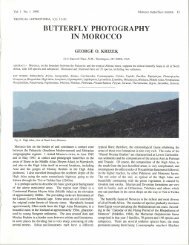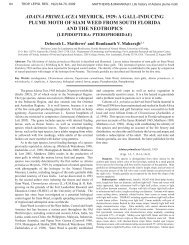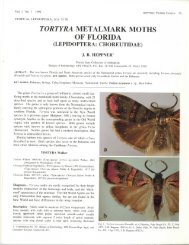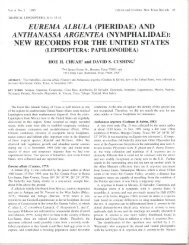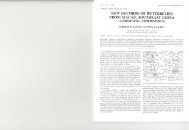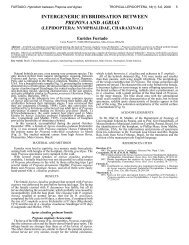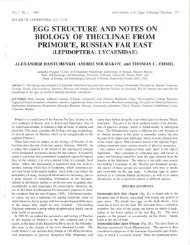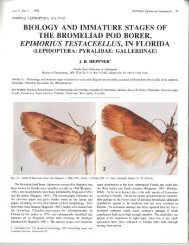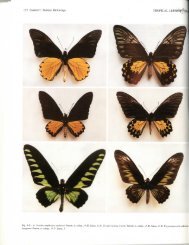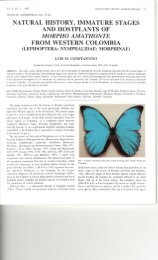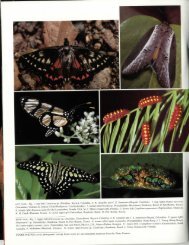the clearwing borers of florida (lepidoptera: sesiidae)
the clearwing borers of florida (lepidoptera: sesiidae)
the clearwing borers of florida (lepidoptera: sesiidae)
You also want an ePaper? Increase the reach of your titles
YUMPU automatically turns print PDFs into web optimized ePapers that Google loves.
Vol. 4 Suppl. 4 1993BROWN & MIZELL: Sesiidae <strong>of</strong> Florida 1TROPICAL LEPIDOPTERA, 4 (Suppl. 4): 1-21THE CLEARWING BORERSOF FLORIDA(LEPIDOPTERA: SESIIDAE)LARRY N. BROWN and RUSSELL F. MIZELL, IIIEnvironmental Studies, Inc., 2410 Old Monticello Rd., Thomasville, Georgia 31792; andNorth Florida Research & Education Center, University <strong>of</strong> Florida,Route 4, Box 4092, Monticello, Florida 32344, USAABSTRACT.- The 41 species <strong>of</strong> <strong>clearwing</strong> moths (Sesiidae) recorded from Florida are described and figured. Information is also summarized on lifehistory, hostplants, flight seasons, sex attractants, and diurnal activity patterns <strong>of</strong> <strong>the</strong> Florida <strong>clearwing</strong> <strong>borers</strong>. The control <strong>of</strong> pest species is alsoincluded.KEY WORDS: Aceraceae, Alcathoe, Aquifoliaceae, behavior, Betulaceae, biology, Canada, Caprifoliaceae, Carmenta, Castanaceae, Casuarinaceae,Compositae, Cornaceae, Cucurbitaceae, distribution, Ebenaceae, ecology, Euhagena, Europe, Fagaceae, hostplants, Hymenoptera, immature stages,luglandaceae, larvae, Leguminosae, life history, Melittia, Mexico, mimicry, Myricaceae, Nyssaceae, North America, Oleaceae, Onagraceae, Osminia,Paranthrene, Pennisetia, pests, Pinaceae, Podosesia, Pompilidae, Ranunculaceae, Rhamnaceae, Rosaceae, Salicaceae, Sannina, Saxifragaceae,Solanaceae, Synan<strong>the</strong>don, taxonomy, Umbelliferae, United States, Vitacea, Vitaceae, West Indies.Clearwing <strong>borers</strong> (family Sesiidae) attack a wide variety <strong>of</strong>shrubs, trees, vines and herbaceous plants. They are major pests<strong>of</strong> fruit trees, shade trees, landscape plants, and certain foresttrees. A total <strong>of</strong> 41 species <strong>of</strong> <strong>clearwing</strong> <strong>borers</strong> have beenrecorded in Florida. Many <strong>of</strong> <strong>the</strong>se species cause serious damage,but <strong>the</strong> damage is <strong>of</strong>ten overlooked or underestimated because <strong>the</strong>symptoms may resemble plant diseases or weakness caused bydrought. The purpose <strong>of</strong> this bulletin is to facilitate identification<strong>of</strong> <strong>the</strong> adult moths and present newly available information on<strong>the</strong>ir life history and damage. Adults <strong>of</strong> all 41 known Floridaspecies are illustrated on Plate 2. Species are listed and illustratedalphabetically; see Appendix 1 for a catalog <strong>of</strong> <strong>the</strong> species inphylogenetic order.Sesiidae moths are known as <strong>clearwing</strong> <strong>borers</strong>. Adult <strong>clearwing</strong>sresemble wasps and bees, and are <strong>of</strong>ten mistaken for <strong>the</strong>m.Their wings are partially or totally devoid <strong>of</strong> <strong>the</strong> microscopicscales found in most moths and <strong>the</strong>ir bodies are <strong>of</strong>ten brightlycolored. They also have <strong>the</strong> ability to hover in one place as dobees and wasps.The larvae <strong>of</strong> <strong>clearwing</strong> moths are white to cream-colored andnearly legless. The caterpillars bore in <strong>the</strong> stems, trunks, and/orroots <strong>of</strong> various plants. Damage from <strong>the</strong> tunneling larvae can besevere and lead to <strong>the</strong> decline and death <strong>of</strong> <strong>the</strong> host trees,especially in younger plants. Damage caused by some species isshown on Fig. 42-45. Typical larvae are illustrated in Fig. 46-48.Female <strong>clearwing</strong>s release sex attractants called pheromonesinto <strong>the</strong> air. These pheromones travel down-wind and stimulate<strong>the</strong> antennae <strong>of</strong> receptive males, which <strong>the</strong>n use <strong>the</strong> sex attractantto locate <strong>the</strong> signaling female. Males can sometimes detectpheromones as far away as one-half to three-fourths <strong>of</strong> a milefrom <strong>the</strong> source.Chemists have identified and syn<strong>the</strong>sized a number <strong>of</strong> <strong>the</strong>pheromones released by several species <strong>of</strong> <strong>clearwing</strong> moths(Barry et al., 1978; Nielsen et al., 1975; Tumlinson et al., 1974).This allows entomologists to attract <strong>the</strong> males <strong>of</strong> many <strong>clearwing</strong>sin large numbers and to study <strong>the</strong>ir mating behavior and flightactivity. Several types <strong>of</strong> moth traps can be baited with variouspheromones or combinations <strong>of</strong> pheromones to clarify <strong>the</strong> lifehistory and seasonal activity <strong>of</strong> many species <strong>of</strong> <strong>clearwing</strong> <strong>borers</strong>(Snow, Eichlin and Tumlinson, 1985).This publication is designed to assist in identification <strong>of</strong> adultmale <strong>clearwing</strong>s attracted to pheromone traps and to relate this tohostplants that may need protection from egg-laying adults atspecific seasons <strong>of</strong> <strong>the</strong> year. Adults <strong>of</strong> both sexes appear similarin most species; <strong>the</strong> few in Florida that are more dimorphic have<strong>the</strong> unusual females also illustrated on Plate 2. Most species <strong>of</strong><strong>clearwing</strong> moths have hatches <strong>of</strong> adults over a ra<strong>the</strong>r narrowtime-window, which, if known, make efforts against <strong>the</strong>m muchmore effective and less expensive than o<strong>the</strong>rwise possible.LIFE HISTORYAdults are almost exclusively active during <strong>the</strong> day and mimicvarious bees and wasps very closely. Adults <strong>of</strong> each speciesemerge during a specific time period, which usually spans onlya few weeks. Adults are also active at only certain hours <strong>of</strong> eachday. Exact times vary from species to species, but most are moreactive before noon.Females commence "calling" behavior (<strong>the</strong> act <strong>of</strong> releasing asex pheromone to lure males for mating) at <strong>the</strong> same time eachday and males actively fly about during this same time period.Females usually emerge from pupation at <strong>the</strong> host plant, andremain in that vicinity, while males tend to fly much longerdistances searching for a calling female.
BROWN & MIZELL: Sesiidae <strong>of</strong> FloridaOviposition by <strong>the</strong> females on <strong>the</strong> host plants begins shortlyafter mating. Eggs are placed singly or in groups on bark orfoliage or in crevices or wounds on <strong>the</strong> host plant. Most<strong>clearwing</strong> species have ra<strong>the</strong>r narrow host preferences, withspecies restricted to a single plant genus or plant family. Someare serious pests <strong>of</strong> landscape and agricultural plants.Clearwing species generally require one year to develop from<strong>the</strong> egg to <strong>the</strong> adult stage (univoltine). A few require two ormore years to complete one life cycle. This is especially truewhen growing conditions are adverse such as drought or on poorsoils.Prior to pupation, <strong>the</strong> caterpillar constructs an exit tunnel to <strong>the</strong>surface <strong>of</strong> <strong>the</strong> plant, leaving a thin layer <strong>of</strong> silk or plant tissueconcealing <strong>the</strong> exit hole. The pupal chamber is silk-lined, andsometimes includes wood particles and larval frass. At <strong>the</strong> time<strong>of</strong> emergence, <strong>the</strong> pupa moves forward and breaks through <strong>the</strong>material concealing <strong>the</strong> exit hole. The adult <strong>the</strong>n emerges from<strong>the</strong> exposed tip <strong>of</strong> <strong>the</strong> pupal case, leaving <strong>the</strong> cast exuviae asclear evidence <strong>the</strong> plant had been attacked by <strong>borers</strong>.IDENTIFYING CLEARWING MOTHSApproximately 125 species <strong>of</strong> <strong>clearwing</strong> <strong>borers</strong> have beenrecorded in <strong>the</strong> United States (Eichlin and Duckworth, 1988), and40 species are known in Florida. Table 1 is a summary <strong>of</strong> <strong>the</strong><strong>clearwing</strong> <strong>borers</strong> <strong>of</strong> Florida toge<strong>the</strong>r with food plants, seasonalflight period, pheromone(s), and common names (see Table 1footnote on common names). Appendix 1 is a catalog <strong>of</strong> <strong>the</strong>Florida Sesiidae; Appendix 2 is a cross-index to <strong>the</strong> <strong>clearwing</strong><strong>borers</strong> occurring on various hosts.Entomologists use several types <strong>of</strong> information to identify <strong>the</strong>male <strong>clearwing</strong> moths which are attracted to pheromones. Theseinclude: 1) coloration and pattern <strong>of</strong> <strong>the</strong> body and wings, 2) shape<strong>of</strong> various body parts, 3) season <strong>of</strong> year <strong>the</strong> adults emerge, 4)time <strong>of</strong> day <strong>the</strong> males are attracted by pheromones, 5) whatspecific pheromone attracts <strong>the</strong> males, and 6) <strong>the</strong> species <strong>of</strong>hostplant utilized by each species. Major adult morphology isshown on Plate 1.AntennaDiscal markBasal area<strong>of</strong> wingAnal tuftSynan<strong>the</strong>don pictipesPlate 1. Morphological characteristics used to identify <strong>clearwing</strong> <strong>borers</strong>.Abdominal segments are numbered from 1-8 anterior to posterior, (after Taft,Smitley and Snow, 1991)SPECIES ACCOUNTSTROPICAL LEPIDOPTERAAlcathoe carolinensis Englehardt Fig. 1Common Name: Tailed Black Clearwing.Description: This is <strong>the</strong> most striking <strong>clearwing</strong> living in Florida,because <strong>of</strong> its large size and long black tail. The entire body isblue-black with a metallic-blue iridescence. The black analappendage (present only in males) extends about one-half inchposteriorly from <strong>the</strong> abdomen. The wings are opaquely blackexcept for oval-shaped (eye-like) transparent windows near <strong>the</strong>base <strong>of</strong> <strong>the</strong> hindwings. Wing length is 12-15mm.Life History: Adults have been taken only in October in Florida.Their flying activity peaks around noon each day. The larvalstages are unknown. The life cycle probably takes one year.Range: Recent records have expanded <strong>the</strong> known range to includeMissouri and Indiana in <strong>the</strong> Midwest, eastward to North Carolinaand south to Florida. In Florida, it is recorded only from <strong>the</strong>nor<strong>the</strong>rn half <strong>of</strong> <strong>the</strong> state.Hostplants: The roots <strong>of</strong> Clematis spp. (Ranunculaceae) vines.Comments: This species appears to mimic a black ichneumonidwasp. Most <strong>of</strong> <strong>the</strong> Florida specimens were taken in or along <strong>the</strong>edges <strong>of</strong> mature floodplain (hydric) forests.Alcathoe caudata (Harris) Fig. 2Common Name: Clematis Borer.Description: This is a strikingly beautiful <strong>clearwing</strong>, but smallerthan Alcathoe carolinensis. Antennae and tail appendage arecanary-yellow in color. The head, thorax, and abdomen arechestnut-brown. The legs are banded orange-red and black.Forewings are completely black with some light orange powderingat <strong>the</strong> lateral margins. Hindwings are transparent except forblack veins and black margins. Wing length is 7-15mm.Life History: Adults emerge from May to September. There isone generation per year.Range: Eastern half <strong>of</strong> <strong>the</strong> United States and sou<strong>the</strong>rn Canada.In Florida, recorded only from <strong>the</strong> nor<strong>the</strong>rn portion <strong>of</strong> <strong>the</strong> state.Hostplants: Wild and cultivated Clematis spp. (Ranunculaceae)vines; also Ribes spp. (Saxifragaceae).Comments: Adults visit flowers for nectar and are active bothmorning and afternoon. They <strong>of</strong>ten rest on <strong>the</strong> foliage <strong>of</strong> <strong>the</strong> hostplant.Carmenta anthracipennis (Boisduval) Fig. 3Common Name: Blazingstar Clearwing.Description: The head, antennae, thorax, and abdomen are black,<strong>the</strong> latter with posterior golden-orange bands on segments 2 to 7.The anal tuft is black. The thorax has a pair <strong>of</strong> thin goldenorangesubdorsal lines. Forewings are opaquely black, <strong>of</strong>ten witha small transparent area proximal and distal to <strong>the</strong> black discalspots. Often <strong>the</strong>re is a powdering <strong>of</strong> golden scales near <strong>the</strong> apex<strong>of</strong> <strong>the</strong> forewings. Hindwings are transparent with lateral fringes<strong>of</strong> black. Wing length is 7-10mm.Life History: Adults emerge in Florida in September andOctober. One generation occurs each year.Range: Eastern two-thirds <strong>of</strong> <strong>the</strong> United States and sou<strong>the</strong>rnCanada. Occurs throughout Florida in xeric sand-hill vegetation
Plate 2. Adults <strong>of</strong> Florida <strong>clearwing</strong> moths: 1. Alcathoe carolinensis; 2. Alcathoe caudata; 3. Carmenta anthracipennis; 4. Carmenta bassiformis; 5. Carmenta ithacae;6. Carmenta laurelae; 1. Carmenta odda; 8. Carmenta pyralidiformis; 9. Carmenta suffusata; 10. Carmenta texana; \\.Euhagena emphytiformis; 12. Melittia cucurbitae,a) d", b) ?; 13. Osminia ruficornis; 14. Paranthrene asilipennis; 15. Paranthrene dollii; 16. Paranthrene simulans; 17. Paranthrene tabaniformis; 18. Pennisetiamarginata; 19. Podosesia aureocincta; 20. Podosesia syringae; 21. Sannina uroceriformis, a) d", b) 9.
~ •) /f
Vol. 4 Suppl. 4 1993and open scrubby woodlands. Active in <strong>the</strong> afternoon.Hostplants: Only <strong>the</strong> roots <strong>of</strong> blazingstar (Liatris spp., Compositae).Comments: The central and south Florida form <strong>of</strong> this <strong>clearwing</strong>has beautiful golden-orange markings compared to <strong>the</strong> paleyellow banding <strong>of</strong> more nor<strong>the</strong>rn populations.Carmenta bassiformis (Walker) Fig. 4Common Name: Ironweed Clearwing.Description: The abdomen is black with each segment narrowlybanded in yellow. Anal tuft is brush-like and black with someyellow laterally. Antennae are black. Forewings are mostlytransparent with a broad black border. The discal bar is blackand <strong>the</strong>re is yellow powdering between <strong>the</strong> veins <strong>of</strong> <strong>the</strong> apicalborders. Hindwings are transparent with very narrow blackborders. Wing length is 6-12mm.Life History: Adults emerge from April to August and are activein <strong>the</strong> late afternoon. Eggs are laid singly at <strong>the</strong> base <strong>of</strong> <strong>the</strong> hostplant or on <strong>the</strong> foliage. Freshly hatched larvae enter <strong>the</strong> stems,eventually boring to <strong>the</strong> roots for <strong>the</strong> winter. In <strong>the</strong> spring <strong>the</strong>ymove back into <strong>the</strong> stems, <strong>of</strong>ten girdling <strong>the</strong>m, causing stems tobreak <strong>of</strong>f several inches above ground.Range: Eastern half <strong>of</strong> <strong>the</strong> United States. Occurs throughoutFlorida in weedy fields and open woodlands containing <strong>the</strong> hostplant.Hostplants: Roots and stems <strong>of</strong> ironweeds (Vernonia spp.,Compositae).Comments: This species is never an agricultural or ornamentalpest.Carmenta ithacae (Beutenmuller) Fig. 5Common Name: Sneezeweed Clearwing.Description: The head, thorax, and abdomen are black, <strong>the</strong> latterhaving very narrow yellow bands on <strong>the</strong> posterior edge <strong>of</strong>segments 2, 4, 6, and 7. The thorax has a pair <strong>of</strong> thin yellowsubdorsal lines. The antennae are black with prominent whitescaling just below <strong>the</strong> tips. The anal tuft forms a broad blackfan, edged in white. Forewings are transparent in center with abroad black border and black discal spot. Some yellow powderingoccurs apically. Wing length is 6-8mm.Life History: Adults emerge from May to August and are activein <strong>the</strong> late morning hours. Larvae bore in <strong>the</strong> stems, crowns, androots. Larvae overwinter in <strong>the</strong> roots and mature in <strong>the</strong> stemsproduced in <strong>the</strong> next growing season.Range: Eastern three-fourths <strong>of</strong> <strong>the</strong> United States and easternMexico. In Florida, recorded only in <strong>the</strong> Panhandle.Hostplants: The only known host plants are sneezeweed (Heleniumspp.), oxeye (Heliopsis spp.), and dog-flea weed (Par<strong>the</strong>niumspp.) (all Compositae).Comments: Usually found in open bottomlands and wet meadowswhere <strong>the</strong> host plants occur.Plate 2 (cont.). 22. Synan<strong>the</strong>don acerni, a)
TABLE 1. Summary <strong>of</strong> Florida <strong>clearwing</strong> moths (Family Sesiidae) with attending biological data for each species.SCIENTIFIC& COMMON NAMESFLIGHTFOOD PLANTSEASONDIURNALPHEROMONE* ACTIVITY**\. Alcathoe carolinensis(Tailed black <strong>clearwing</strong>)ClematisJuly-Oct2,2/1(3:1)MD2. Alcathoe caudata(Clematis borer)ClematisMay-Sept5,1/2(1:1)M,A3. Carmenta anthracipennis(Blazingstar <strong>clearwing</strong>)LiatrisSept-Oct1,1/2(1:1)A4. Carmenta bassiformis(Ironweed <strong>clearwing</strong>)VernoniaApr-Aug1/4(1:1)LA5. Carmenta ithacae(Sneezeweed <strong>clearwing</strong>)Helenium,HeliopsisMay-Aug1,1/2(9-1)M6. Carmenta laurelae(Swamp <strong>clearwing</strong>)UnknownMay-June1MD7. Carmenta odda(Odda <strong>clearwing</strong>)UnknownMay-June1,1/2(1:1)MD8. Carmenta pyralidiformis(Eupatorium <strong>clearwing</strong>)EupatoriumAug-Oct4/5(1:1)LA9. Carmenta suffusata(Silver-black <strong>clearwing</strong>)UnknownMay-Aug5LA10. Carmenta texana(Texas <strong>clearwing</strong>)Artemisia;Various forbsMar-Dec1,1/2(1:1),1/5(1:1)MD11. Euhagena emphytiformis(Gaura <strong>clearwing</strong> borer)GauraJuly-Sept1U12. Melittia cucurbitae(Squash vine borer)®CucurbitaApr-Nov3MD13. Osminia ruficornis(Minute <strong>clearwing</strong>)UnknownAug-Sept6LA14. Paranthrene asilipennis(Oak <strong>clearwing</strong> borer)®QuercusFeb-May1,7LA15. Paranthrene dollii(Poplar <strong>clearwing</strong> borer)PopulusSalixMar-June;Sept-Nov4/5(1:1)M,A16. Paranthrene simulans(Golden oak borer)QuercusApr-Aug1,3,1/2(1:1)LA17. Paranthrene tabaniformis(Dusky <strong>clearwing</strong> borer)Salix, PopulusApr-Aug5M,A18. Pennisetia marginata(Raspberry crown borer)®RubusJuly-Nov5M,A19. Podosesia aureocincta(Banded ash <strong>clearwing</strong>)®FraxinusJuly-Sept1MD20. Podosesia syringae(Ash borer)@Fraxinus,SyringaDec -July1,1/4(1:1)MD
Vol. 4 Suppl. 4 1993BROWN & MIZELL: Sesiidae <strong>of</strong> Florida 721. Sannina uroceriformis(Persimmon borer)®DiospyrosvirginianaMar-May5,4/5(1:1)M22. Synan<strong>the</strong>don acerni(Maple callus borer)®AcerApr-Sept1,1/5(9:1)LA23. Synan<strong>the</strong>don acerrubri(Red maple borer)AcerApr-Aug3U24. Synan<strong>the</strong>don alleri(Aller's <strong>clearwing</strong>)UnknownMar-Dec5MD25. Synan<strong>the</strong>don arkansasensis(Arkansas <strong>clearwing</strong>)UnknownApr-Dec2.5LA26. Synan<strong>the</strong>don castaneae(Chestnut borer)CastaneaApr-July5U27. Synan<strong>the</strong>don decipiens(Oak gall borer)Quercus gallsMar-Nov1,3,1/2(1:1)A28. Synan<strong>the</strong>don dominicki(Dominick's <strong>clearwing</strong>)UnknownMar-Apr3A29. Synan<strong>the</strong>don exitiosa(Peachtree borer)®PrunusMay-Nov1MD30. Synan<strong>the</strong>don fatifera(Viburnum borer)ViburnumMay-June1,1/2(9:1)LA31. Synan<strong>the</strong>don geliformis(Red <strong>clearwing</strong> borer)Many treesMar-Dec1,1/4(1:1)LA32. Synan<strong>the</strong>don pictipes(Lesser peachtree borer)®PrunusYear-round3MD33. Synan<strong>the</strong>don proximo(Willow borer)SalixApr-July1U34. Synan<strong>the</strong>don refulgens(Refulgens <strong>clearwing</strong>)UnknownApr-Sept3,3/1(99:1)U35. Synan<strong>the</strong>don richardsi(Richard's <strong>clearwing</strong>)UnknownOctUnknownU36. Synan<strong>the</strong>don rileyana(Riley's <strong>clearwing</strong>)SolanumcarolinenseJune-Sept5,4/5(1:1)M37. Synan<strong>the</strong>don rubr<strong>of</strong>ascia(Black gum borer)NyssaMar-Nov1/2(1:1)A38. Synan<strong>the</strong>don sapygaeformis(Florida <strong>clearwing</strong>)Quercus gallsYear-round1,1/2(1:1)MD39. Synan<strong>the</strong>don scitula(Dogwood borer)®Many treesMar-Oct1LA40. Vitacea polistiformis(Grape root borer)®VitisMay-Oct3LA41. Vitacea scepsiformis(Lesser grape root borer)®VitisPar<strong>the</strong>nocissusJuly-Nov1,2,1/2(1:1)LA
8 BROWN & MIZELL: Sesiidae <strong>of</strong> Florida TROPICAL LEPIDOPTERX(Eupatorium spp., Compositae) <strong>of</strong> herbs.Comments: This species occurs in sand hills, open flatwoods,and open pine-oak woodlands containing <strong>the</strong> host plants. Floridaspecimens have red-orange markings ra<strong>the</strong>r than <strong>the</strong> yellow <strong>of</strong>more nor<strong>the</strong>rn populations.Carmenta suffusata Engelhardt Fig. 9Common Name: Silver-black Clearwing.Descriptions: This is a small, very stream-lined <strong>clearwing</strong> withsilver and black markings. The head, thorax, antennae, andabdomen are black, <strong>the</strong> latter with a narrow silver-white band on<strong>the</strong> posterior margin <strong>of</strong> segment 4. The ventral side <strong>of</strong> <strong>the</strong>abdomen is silver-white. Forewings are opaquely brown-black,and weakly powdered with silver-white scales. The hindwingsare also opaquely brown-black, with small transparent windowsbasally. The anal tuft is a narrow, elongate brush, black in color,with silver-white hair-like setae on <strong>the</strong> ventral side. Wing lengthis 5-9mm.Life History: The adults emerge from May to August with anoccasional straggler in <strong>the</strong> fall. Daily flight activity peaks in <strong>the</strong>late afternoon between 5:00 and 6:00pm. Very little else isknown <strong>of</strong> <strong>the</strong> life cycle <strong>of</strong> this species.Range: Western Kansas south to Texas and east to Florida. InFlorida, only collected from <strong>the</strong> nor<strong>the</strong>rn half <strong>of</strong> <strong>the</strong> state thus far.Hostplants: Unknown. The type specimen was reared from <strong>the</strong>tap root <strong>of</strong> an unidentified prairie plant in Oklahoma.Comments: Using <strong>the</strong> pheromone, (E, Z) 3, 13-ODDOH, largenumbers <strong>of</strong> males have been taken in open turkey-oak pine, sandpine-scrub, and o<strong>the</strong>r sand hill plant communities in Florida.Carmenta texana (H. Edwards) Fig. 10Common Name: Texas Clearwing.Description: Head, antennae, and thorax black, <strong>the</strong> latter with apair <strong>of</strong> subdorsal orange stripes. Abdomen is black with orangebands in <strong>the</strong> posterior margins <strong>of</strong> segments 2, 4, 6, 7, andoccasionally 5 (4 is <strong>the</strong> widest). The anal tuft is large, truncate,and black with orange lateral edges. Forewings are black,opaque in <strong>the</strong> distal half, and transparent in <strong>the</strong> center <strong>of</strong> <strong>the</strong> basalTABLE 1 (com.)* Pheromones listed are only a general guide; <strong>clearwing</strong>s may be attracted tomore than one chemical or blend. Number key to pheromones are:1. (Z,Z) 3,13-octadecadien-l-ol acetate2. (E,Z) 3,13-octadecadien-l-ol acetate3. (E,Z) 2,13-octadecadien-l-ol acetate4. (Z,Z) 3,13-octadecadien-l-ol alcohol5. (E,Z) 3,13-octadecadien-l-ol alcohol6. (E,Z) 2,13-octadecadien-l-ol alcohol7. (Z) 13-octadeceryl acetate** Key to <strong>the</strong> peak time <strong>of</strong> daily flight period by males are:M = MorningMD = Mid-dayA = AfternoonLA = Late Afternoon? The common names for <strong>the</strong>se <strong>borers</strong> have been approved by <strong>the</strong> Committee onCommon Names <strong>of</strong> Insects <strong>of</strong> <strong>the</strong> Entomological Society <strong>of</strong> America. All o<strong>the</strong>rcommon names have not been approved and may vary by author. Scientificnames should be used for obtaining fur<strong>the</strong>r information.half. Discal spot is large, black, and <strong>the</strong>re is a small transparentarea distal to <strong>the</strong> discal spot. Wing length is 6-11mm.Life History: Adults emerge from March to December, and aremost active at mid-day. Larvae bore in <strong>the</strong> crown roots andstems <strong>of</strong> <strong>the</strong> plant. There is one generation per year.Range: Along <strong>the</strong> Gulf Coast <strong>of</strong> United States from Georgia andFlorida to Texas. Also, probably occurs in eastern Mexico.Found statewide in Florida.Hostplants: Sage (Artemisia spp.), fennel (Eupatorium spp.),ragweed (Ambrosia spp.), Melan<strong>the</strong>ra spp., Grindelia spp., andFlaveria spp. (all Compositae); also Foeniculum spp. (Umbelliferae).Comments: This species is very abundant in fields, pastures, anddisturbed areas where <strong>the</strong> food plants occur.Euhagena emphytiformis (Walker) Fig. 11Common Name: Gaura Clearwing Borer.Description: This <strong>clearwing</strong> somewhat resembles a yellow jacket.The abdomen is banded yellow and black, mixed with varyingamounts <strong>of</strong> burnt-orange. Forewings are black mixed with yellowand burnt-orange between <strong>the</strong> veins. Hindwings are clear basallyand distally colored like <strong>the</strong> forewings. Wing length is 8-14mm.Life History: Larvae bore in <strong>the</strong> perennial main roots <strong>of</strong> Gauraspp. Adults emerge from July to September. It is not known if<strong>the</strong>y require more than one year to mature.Range: Occurs along <strong>the</strong> Atlantic and Gulf coastal plains fromSouth Carolina to Texas and Mexico, northward to Colorado andWyoming, and westward to sou<strong>the</strong>rn Arizona. Occurs in sandhill and open scrub habitats over much <strong>of</strong> nor<strong>the</strong>rn and centralFlorida.Hostplants: Only Gaura spp. (Onagraceae).Comments: Since this <strong>clearwing</strong> attacks only one species <strong>of</strong>deep-rooted herbaceous perennial, it is not an agricultural pest.Melittia cucurbitae (Harris) Fig. 12Common Name: Squash Vine Borer.Description: This is a robust moth with prominent brush-like redand black scales on <strong>the</strong> hiiid legs. The forewings are coveredheavily with shiny black scales. The hindwings are transparentwith black veins and a heavy black fringe along <strong>the</strong> posteriorborder. The antennae are black and white. Wing length is 12-15mm.Life History: Larvae tunnel in <strong>the</strong> stems <strong>of</strong> host plants. Pupationoccurs during spring or summer in <strong>the</strong> soil beneath <strong>the</strong> food plant,and adults usually emerge from <strong>the</strong>ir cocoons <strong>the</strong> followingspring. Females tend to remain at or near <strong>the</strong> emergence site andbegin emitting pheromone to attract a male. In Florida, adultscan be taken from April to November indicating strongly <strong>the</strong>reare at least two broods a year.Range: Eastern two-thirds <strong>of</strong> <strong>the</strong> United States and Canada, aswell as eastern Mexico. Occurs statewide in Florida.Hostplants: Stems <strong>of</strong> squash, pumpkins, and gourds (Cucurbitaspp., Cucurbitaceae).Comments: This is a major pest <strong>of</strong> cultivated squash, pumpkinsand gourds. Melons and cucumbers are less <strong>of</strong>ten attacked. Theleaves <strong>of</strong> infested plants appear wilted and turn yellow from <strong>the</strong>base <strong>of</strong> <strong>the</strong> plant outward.
10 BROWN & MIZELL: Sesiidae <strong>of</strong> Florida TROPICAL LEPIDOPTERALife History: Eggs are laid on <strong>the</strong> foliage <strong>of</strong> <strong>the</strong> host plant andyoung larvae move down to feed on <strong>the</strong> roots. The followingyear, larger larvae <strong>of</strong>ten girdle <strong>the</strong> stems just above ground level,causing <strong>the</strong>m to wilt or break <strong>of</strong>f. Pupation occurs in <strong>the</strong> hollowcane stump and adults emerge from July to November. The lifecycle takes two or three years.Range: Found throughout <strong>the</strong> United States and sou<strong>the</strong>rn Canada.Occurs statewide in Florida.Hostplants: Wild and cultivated blackberry, raspberry, boysenberry,and dewberry (Rubus spp., Rosaceae).Comments: A serious pest <strong>of</strong> cultivated raspberries, blackberries,and boysenberries. Many canes wilt and break <strong>of</strong>f if heavilyinfested.Podosesia aureocincta Purrington & Nielsen Fig. 19Common Name: Banded Ash Clearwing.Description: This is an excellent mimic <strong>of</strong> <strong>the</strong> red paper wasp.The head, antennae, and thorax are rust-brown and black. Theabdomen is black or brown-black, somewhat constricted at base,and <strong>the</strong>re is a distinct yellow-orange band on segment 4. Thelegs are banded rust-brown and yellow along <strong>the</strong>ir distal portions.Forewings are opaquely black with rust-red scales near <strong>the</strong> base.Hindwings are mostly transparent with black veins. Wing lengthis 10-17mm.Life History: Adults emerge from mid-July to early December inFlorida, so <strong>the</strong>re is very little or no overlap with P. syringae.Eggs are deposited on <strong>the</strong> limbs and tree trunk, and larvae borein <strong>the</strong> wood <strong>of</strong> both. A year is required to complete one lifecycle.Range: Eastern half <strong>of</strong> <strong>the</strong> United States from New York south.Occurs over <strong>the</strong> nor<strong>the</strong>rn three-fourths <strong>of</strong> Florida.Hostplants: Various species <strong>of</strong> ash (Fraxinus spp., Oleaceae).Comments: Heavy infestations result in swelling and cracking <strong>of</strong>bark as well as branch dieback in <strong>the</strong> trees.Podosesia syringae (Harris) Fig. 20Common Name: Ash Borer.Description: This species is almost identical to Podosesiaaureocincta, except it lacks <strong>the</strong> yellow abdominal band. Theabdomen is entirely black or brown-black and somewhat constrictedat <strong>the</strong> base. The wing and o<strong>the</strong>r body parts are coloredas in <strong>the</strong> banded ash borer. Wing length is 10-17mm.Life History: Adults emerge from mid-December to early July inFlorida, so <strong>the</strong>re is very little or no overlap with P. aureocincta.Eggs are deposited on <strong>the</strong> limbs and tree trunks, and larvae borein <strong>the</strong> wood <strong>of</strong> both. One generation occurs each year.Range: Eastern two-thirds <strong>of</strong> <strong>the</strong> United States and sou<strong>the</strong>rnCanada, plus disjunct populations in central California and <strong>the</strong>Pacific Northwest. Occurs over <strong>the</strong> nor<strong>the</strong>rn three-fourths <strong>of</strong>Florida.Hostplants: Larvae bore in various species <strong>of</strong> ashes (Fraxinusspp.), lilacs (Syringa spp.), olive (Olea spp.), Ligustrum spp., andfringe tree (Chionanthus spp.) (all Oleaceae).Comments: This borer causes serious damage to nursery stockand landscape plantings.Sannina uroceriformis Walker Fig. 21Common Name: Persimmon Borer.Description: Adults mimic <strong>the</strong> large black and red wasp (Lophopompilusatrox). The head, antennae, thorax, and abdomen areblue-black, <strong>the</strong> latter banded with red-orange on segment 4 and<strong>of</strong>ten <strong>the</strong> anterior edge <strong>of</strong> segment 5. There are also small redorangemarkings on <strong>the</strong> head and lateral thorax. The wings areopaque and blue-black, with small transparent windows at <strong>the</strong>base. There are five prominent black, hair-pencil anal tufts on<strong>the</strong> male (2 short lateral, 2 long lateral, and 1 long dorsal). Winglength is 12-17mm.Life History: Eggs are laid at <strong>the</strong> base <strong>of</strong> <strong>the</strong> tree, and larvaebore as deep as 18 inches into <strong>the</strong> central root. The life cyclerequires two years or occasionally three. The cocoons containwood chips and frass, and extend out from <strong>the</strong> base <strong>of</strong> <strong>the</strong> tree atground level. The pupa, if disturbed, drops rapidly back into <strong>the</strong>larval tunnel. Adults emerge from March to May in Florida and<strong>the</strong>re are occasionally a few stragglers later in <strong>the</strong> summer.Range: Eastern two-thirds <strong>of</strong> <strong>the</strong> United States from New Jerseysouthward. Occurs statewide in Florida.Hostplants: Common persimmon tree (Diospyros virginiana,Ebenaceae). Some western records are outside <strong>the</strong> geographicalrange <strong>of</strong> persimmons so <strong>the</strong>re could be a secondary host.Comments: This borer is a serious pest <strong>of</strong> young persimmontrees, weakening or killing many <strong>of</strong> <strong>the</strong>m.Synan<strong>the</strong>don acerni (Clemens) Fig. 22Common Name: Maple Callus Borer.Description: This is <strong>the</strong> only Florida <strong>clearwing</strong> having a goldenthorax and a brown abdomen with a bright-orange anal tuft. Allfour wings are transparent with light yellow scales near <strong>the</strong> tipsand black discal spots. The head is red-orange and <strong>the</strong> antennasare dark brown. Wing length is 7-13mm.Life History: Larvae bore in damaged areas on <strong>the</strong> trunk andlarge limbs causing a swelling (calous) or rough area on <strong>the</strong>surface. The damaged area is reinfested each year and graduallygrows larger. Adults fly in <strong>the</strong> late afternoon, and are one <strong>of</strong> <strong>the</strong>few <strong>clearwing</strong>s also attracted to bright lights at night. Each broodmatures in one year and adults emerge from April to September.Range: Eastern half <strong>of</strong> <strong>the</strong> United States and Canada. Occursstatewide in Florida.Hostplants: Various maple (Acer spp., Aceraceae) species.Comments: This is a serious pest <strong>of</strong> maple trees in nurseries andlandscapes.Synan<strong>the</strong>don acerrubri Englelhardt Fig. 23Common Name: Red Maple Borer.Description: The abdomen is metallic blue-back on <strong>the</strong> dorsalside and brick-red ventrally. Segments 2, 4, 5 and 6 are narrowlyedged with pale yellow. Antennae are black with white scalesnear <strong>the</strong> tips. Forewings are tipped in black and have a blackdiscal bar. Hindwings are transparent and fringed with a blackline. The anal tuft is fan-shaped, blue-black above and brick-redbeneath. Wing length is 6-10mm.Life History: Larvae bore under <strong>the</strong> bark <strong>of</strong> tree branchescausing a slight swelling. They complete <strong>the</strong> life cycle in oneyear. Adults emerge from April to August. Eggs are laid at
Vol. 4 Suppl. 4 1993 BROWN & MIZELL: Sesiidae <strong>of</strong> Florida 11injured or damaged areas. Cocoons are made <strong>of</strong> wood chips andfrass, just under <strong>the</strong> bark.Range: Eastern half <strong>of</strong> <strong>the</strong> United States and Canada. In Florida,this species has only been recorded in <strong>the</strong> Panhandle near <strong>the</strong>Alabama and Georgia borders.Hostplants: Various species <strong>of</strong> maple (Acer spp., Aceraceae). InFlorida, red maple (Acer rubrum) is <strong>the</strong> main host species.Comments: This borer is not as widespread or damaging tomaples as <strong>the</strong> maple callus borer (S. acerni) in Florida.Synan<strong>the</strong>don alleri (Engelhardt) Fig. 24Common Name: Aller's Clearwing.Description: The head, antennae, and thorax are black, <strong>the</strong> latterwith a pair <strong>of</strong> narrow orange sub-dorsal stripes. The abdomen isblack with a metallic blue-green luster and an orange band on <strong>the</strong>junction <strong>of</strong> segments 4 and 5. The anal tuft is large, wedgeshaped,and black with <strong>the</strong> lateral margins white. Forewings areblack with orange scales between veins apically. Hindwings aretransparent. Wing length is 9-12mm.Life History: The life cycle is poorly known, but adults emergefrom March to December. Numbers peak around noon atpheromone lures. There may be two broods annually in Florida.Range: Occurs across <strong>the</strong> Gulf coastal plain from Georgia toMississippi thus far. Occurs statewide in Florida.Hostplants: Unknown, but very possibly various species <strong>of</strong> holly(Ilex spp., Aquifoliaceae). Large numbers have been taken inopen woodlands, abounding in holly, bordering hydric forests.Comments: A melanistic color phase <strong>of</strong> Aller's <strong>clearwing</strong> isra<strong>the</strong>r common in Florida (about 5% <strong>of</strong> those captured).Synan<strong>the</strong>don arkansasensis Duckworth & EichlinCommon Name: Arkansas Clearwing. Fig. 25Description: Head, antennae, and thorax blue-black, <strong>the</strong> latterwith a pair <strong>of</strong> narrow yellow sub-dorsal stripes. The abdomen isblue-black with narrow yellow bands on <strong>the</strong> posterior edge <strong>of</strong>each segment. Anal tuft is golden- orange. Forewings are twothirdstransparent, <strong>the</strong> rest black, with orange in <strong>the</strong> apical areas(between veins and outlining <strong>the</strong> discal spot). Hindwings aretransparent. Wing length is 7-10mm.Life History: The life cycle is poorly known, but adults emergefrom April to December. Numbers peak in <strong>the</strong> late afternoon atpheromone lures. Like S. acerni, adults <strong>of</strong> this species are <strong>of</strong>tentaken at insect lights at night. Apparently one brood per year.Range: South central and sou<strong>the</strong>rn United States. In Florida,restricted to <strong>the</strong> nor<strong>the</strong>rn portion <strong>of</strong> <strong>the</strong> state.Hostplants: Unknown.Comments: Appears not to be a pest <strong>of</strong> any agriculture ornursery species.Synan<strong>the</strong>don castaneae (Busck) Fig. 26Common Name: Chestnut Borer.Description: The abdomen is black with a blue-green iridescenceand very narrow yellow bands on segment 2, 3, and 4. Thethorax, head, and antennae are also black. Forewings andhindwings are transparent, with a small black discal bar on <strong>the</strong>fore wing. Wing length is 10-12mm.Life History: Larvae bore in <strong>the</strong> bark <strong>of</strong> <strong>the</strong> tree trunk preferringbruised or damaged areas. The life cycle requires one year andadults emerge from late April to June (cocoons are spun in <strong>the</strong>larval galleries).Range: Eastern third <strong>of</strong> <strong>the</strong> United States from Atlantic coaststates southward to Florida. In Florida, recorded only in <strong>the</strong>Panhandle.Hostplants: Feed on chestnuts and probably chinquapins (Castaneaspp., Castanaceae).Comments: Was thought to be extinct for many years because <strong>of</strong>demise <strong>of</strong> <strong>the</strong> host tree (due to <strong>the</strong> chestnut blight). Rediscoveredin 1985 using pheromones and found to be relatively common inseveral states. Not a pest today, may be in future if <strong>the</strong> Americanchestnut (Castanea dentata) makes a comeback.Synan<strong>the</strong>don decipiens (H. Edwards) Fig. 27Common Name: Oak Gall Borer.Description: A small species in which <strong>the</strong> head, antennae, andthorax are black, <strong>the</strong> latter with a pair <strong>of</strong> yellow sub-dorsal lines.The abdomen is black with segments 2, 6, and 7 narrowly bandedin canary-yellow. Also, segment 4 has a broader yellow band.The black anal tuft is wedge-shaped with lateral margins yellow.Forewings are mostly transparent with black fringes and veins,plus a red discal spot. Hindwings are transparent with blackfringes and veins. Wing length is 8-10mm.Life History: Larvae tunnel in <strong>the</strong> large woody galls <strong>of</strong> cynipidwasps or under <strong>the</strong> bark <strong>of</strong> trees. Adults emerge from March toNovember and <strong>the</strong>re appears to be two peaks (one in <strong>the</strong> springand ano<strong>the</strong>r in <strong>the</strong> fall) in Florida. These <strong>borers</strong> complete <strong>the</strong>irlife cycle in one year.Range: Eastern two-thirds <strong>of</strong> <strong>the</strong> United States and Canada.Occurs statewide in Florida.Hostplants: Prefers various species <strong>of</strong> scrub oaks (Quercus spp.,Fagaceae) but also occurs in larger species <strong>of</strong> oaks.Comments: Color forms <strong>of</strong> this species with reduced yellowabdominal banding have been noted in parts <strong>of</strong> Florida (especiallyin small, undernourished specimens).Synan<strong>the</strong>don dominicki Duckworth & EichlinCommon Name: Dominick's Clearwing. Fig. 28Description: The head, antennae, and thorax are blue-black, <strong>the</strong>latter with a pair <strong>of</strong> dorsal orange stripes. Abdomen is metallicblue-black with a prominent anal tuft which is mainly orange-redexcept for blue-back on basal one/third. Forewings are transparentin <strong>the</strong> basal two-thirds and tipped with blue-back and orangescales. Hindwings are transparent. Wing length is 7-10mm.Life History: Most <strong>of</strong> <strong>the</strong> life cycle is unknown. Adults emergeonly in March and April. There is one brood per year. Adultsare most active at mid-afternoon.Range: Taken only in North Carolina, South Carolina, Georgia,Florida, and Alabama. Occurs throughout <strong>the</strong> nor<strong>the</strong>rn two-thirds<strong>of</strong> Florida.Hostplants: Unknown.Comment: This moth is beautifully marked in both sexes. Thefemale <strong>of</strong> <strong>the</strong> species was unknown until fairly recently when onewas captured while hovering over and intermittently landing ona small waterlocust (Gleditsia aquatica). It was not possible todetermine if this is <strong>the</strong> host species.
12 BROWN & MIZELL: Sesiidae <strong>of</strong> Florida TROPICAL LEPIDOPTERA; 'Synan<strong>the</strong>don exitiosa (Say) Fig. 29Common Name: Peachtree Borer.Description: The head is black with yellow dorsally. Antenna,thorax and abdomen are metallic blue-black color with narrowpale-yellow bandin present on most <strong>of</strong> <strong>the</strong> segments. The analtuft is elongated, black, and wedge-shaped. The wings have atransparent amber sheen with black veins and black margins.Wing length is normally 10-15mm.Life History: The life cycle <strong>of</strong> this species is probably <strong>the</strong> bestknown <strong>of</strong> any <strong>clearwing</strong>. Adults emerge from May to Novemberand <strong>the</strong>re is one generation per year. Peak flying and breedingactivity occur around noon each day. Larvae bore beneath <strong>the</strong>bark and cambium in <strong>the</strong> trunk, just above and below groundlevel. At pupation, <strong>the</strong>y spin cocoons in <strong>the</strong> larval galleries or in<strong>the</strong> soil at <strong>the</strong> base <strong>of</strong> trees.Range: Throughout <strong>the</strong> United States and sou<strong>the</strong>rn Canada,excluding most <strong>of</strong> <strong>the</strong> Great Plains, Great Basin, and desertSouthwest. Occurs statewide in Florida.Hostplants: Wild and cultivated cherries, peaches, plums,apricots, almonds, nectarines, and o<strong>the</strong>r stone fruits <strong>of</strong> <strong>the</strong> genusPrunus; also Amelanchier spp., and Malus sp. (all Rosaceae).Comments: This is one <strong>of</strong> <strong>the</strong> most economically destructive<strong>clearwing</strong>s. They cause <strong>the</strong> decline and death <strong>of</strong> millions <strong>of</strong>Prunus. Female peachtree <strong>borers</strong> are black and red-orange incoloration, thus <strong>the</strong>y mimic a different species <strong>of</strong> wasp (possiblyspider wasps, Pompilidae) than males.Synan<strong>the</strong>don fatifera Hodges Fig. 30Common Name: Arrowwood Borer.Description: The head, thorax, antennae, and abdomen aremetallic blue-black. The anal tuft is elongate, blue-black edgedthinly with pale yellow, and wedge-shaped. The wings aretransparent, bordered in blue-black. Wing length is 9-11 mm.Life History: Adults emerge in May and June. There is onegeneration per year, and <strong>the</strong> larvae bore in <strong>the</strong> trunk and majorbranches <strong>of</strong> <strong>the</strong> trees. The daily activity period <strong>of</strong> adults occursin late afternoon.Range: Occurs widely east <strong>of</strong> <strong>the</strong> Rocky Mountains in <strong>the</strong> UnitedStates and sou<strong>the</strong>rn Canada. Recorded from <strong>the</strong> nor<strong>the</strong>rn half <strong>of</strong>Florida.Hostplants: Viburnum spp. (Caprifoliaceae) trees and shrubs.Comments: This borer commonly damages nursery and landscapeplants. Adult males are attracted to ZZA, while <strong>the</strong> nearlyidentical lesser peach tree borer is attracted to EZA.Synan<strong>the</strong>don geliformis (Walker) Fig. 31Common Name: Red Clearwing Borer.Description: The head, antennae, and thorax are black, but <strong>the</strong>abdomen is entirely orange-red. The anal tuft is red with blackalong <strong>the</strong> margins. Forewings are uniformly black and <strong>the</strong>hindwings are transparent bordered with black. Wing length is 6-9mm.Life History: Adults can be taken from March to December inFlorida. Larvae prefer to tunnel in damaged or injured planttissues just under <strong>the</strong> bark. There may be two broods per year insou<strong>the</strong>rn areas. The daily activity period <strong>of</strong> adults occurs in <strong>the</strong>late afternoon.Range: The sou<strong>the</strong>astern coastal plains <strong>of</strong> <strong>the</strong> United States(South Carolina, Georgia, and statewide in Florida). Also foundin <strong>the</strong> West Indies and eastern Mexico.Hostplants: One <strong>of</strong> <strong>the</strong> few "polyphagous" <strong>clearwing</strong>s, utilizinga number <strong>of</strong> unrelated host plants including Carya spp. (Juglandaceae),Quercus spp. (Fagaceae), Cornus spp. (Cornaceae), Ulmusspp. (Ulmaceae), Hibiscus spp. (Malvaceae), and Casuarina spp.(Casuarinaceae).Comments: This borer commonly damages nursery and landscapeplants in Florida and adjacent areas. It has been a major pest <strong>of</strong>elm nursery stock in <strong>the</strong> Tampa area.Synan<strong>the</strong>don pictipes (Grote & Robinson) Fig. 32Common Name: Lesser Peachtree Borer.Description: The head, antenna, and thorax are blue-black, <strong>the</strong>latter with two subdorsal yellow lines. Abdomen and anal tuftare blue-black with <strong>the</strong> latter being elongate and wedge-shaped.The wings are transparent with a metallic blue-black fringe anddiscal bar. Wing length is 8-12mm.Life History: This species is almost as well studied as <strong>the</strong>peachtree borer. Adults are on <strong>the</strong> wing year-round in Florida,but fewer in number during <strong>the</strong> winter. Daily flight and breedingactivities peak around noon. Larvae tunnel under <strong>the</strong> bark in <strong>the</strong>twigs and branches <strong>of</strong> <strong>the</strong> trees ra<strong>the</strong>r than <strong>the</strong> lower trunk.There are at least two generations per year in Florida.Range: Eastern half <strong>of</strong> <strong>the</strong> United States and sou<strong>the</strong>rn Canada.Statewide in Florida.Hostplants: Cultivated and wild peaches, plums and cherries(Prunus spp.); also Amelanchier spp., apples (Malus spp.) andpears Pyrus spp. (all Rosaceae).Comments: This is one <strong>of</strong> <strong>the</strong> most economically destructive<strong>clearwing</strong>s. Ornamental (flowering) members <strong>of</strong> <strong>the</strong> Prunusgroup are attacked as heavily as <strong>the</strong> fruiting varieties.Synan<strong>the</strong>don proxima (H. Edwards) Fig. 33Common Name: Willow Borer.Description: The head, thorax, and abdomen are metallic blueblack,and <strong>the</strong> antennae are blue-black with striking white areasnear <strong>the</strong> tips. The anal tuft is wedge-shaped and blue-black withwhite lateral fringes. The wings are transparent, but <strong>the</strong> veins,outer margins, and discal bars are metallic black. Wing length is8-10mm.Life History: Adults emerge from April to July. Larvae infestbranches, canes, or exposed roots <strong>of</strong> <strong>the</strong> tree. One year isrequired to complete <strong>the</strong> life cycle.Range: Eastern half <strong>of</strong> <strong>the</strong> United States and sou<strong>the</strong>rn Canadawest to Manitoba and eastern Nebraska. In Florida, recordedonly from <strong>the</strong> nor<strong>the</strong>rn edge <strong>of</strong> <strong>the</strong> state.Hostplants: Various species <strong>of</strong> willows (Salix spp., Salicaceae).They prefer <strong>the</strong> low-growing bushy types.Comments: Nursery stocks are occasionally attacked and weakenedby this borer, but it is more <strong>of</strong>ten found on wild species <strong>of</strong>willows.Synan<strong>the</strong>don refulgens (H. Edwards) Fig. 34Common Name: Refulgens Clearwing.Description: The abdomen is brown-black with segments 2, 4, 6
Vol. 4 Suppl. 4 1993 BROWN & MIZELL: Sesiidae <strong>of</strong> Florida 13and 7 banded with yellow (3 and 5 sometimes faintly banded).Life History: The life cycle is poorly known, but adults emergefrom April to September. They respond to <strong>the</strong> sex attractant mix<strong>of</strong> (E, Z) 2, 13-ODDA/ZZA at a 99:1 ratio. Wing length ismm.Range: Eastern half <strong>of</strong> <strong>the</strong> United States. Recorded from <strong>the</strong>nor<strong>the</strong>rn two-thirds <strong>of</strong> Florida.Hostplants: Unknown.Comments: This species is usually captured in xeric turkey oakpineor sand pine-scrub forests in Florida.Synan<strong>the</strong>don richardsi (Engelhardt) Fig. 35Common Name: Richard's Clearwing.Description: The abdomen is black on <strong>the</strong> dorsal side and paleyellow and white ventrally. Antennae are black with <strong>the</strong> apicalthird powdered white. Forewings are mostly hyaline with broadblack outer margins, and strongly orange between <strong>the</strong> veins. Thediscal bar is black, and <strong>the</strong> anal tuft is red orange with someblack setae near <strong>the</strong> base. Hindwings are hyaline with narrowyellow and orange outer margins.Life History: Almost nothing is known about <strong>the</strong> life cycle <strong>of</strong>this rarely-collected <strong>clearwing</strong> moth. It has been taken in mid-October at Torreya State Park in <strong>the</strong> Florida Panhandle.Range: Found throughout <strong>the</strong> Appalachian Plateau from Marylandsouth to Georgia and into north Florida, west to Ohio and Kansas.Hostplants: Unknown, but has been captured on buttonbush(Rubiaceae). This may be only a nectar source.Comments: Only a single specimen is presently recorded fromFlorida, taken at Torreya State Park, Liberty County. Researchis needed to determine <strong>the</strong> extent <strong>of</strong> its range in nor<strong>the</strong>rn Florida.Synan<strong>the</strong>don rileyana (H. Edwards) Fig. 36Common Name: Riley's Clearwing.Description: This is an excellent mimic <strong>of</strong> <strong>the</strong> yellow jacket.The stout abdomen is black, banded broadly with yellow in <strong>the</strong>posterior edge <strong>of</strong> each segment. Forewings are transparent andboldly marked with a red oval-shaped discal spot. The wings areall bordered with black and <strong>the</strong> veins are black. Hind legs arecovered with long hair-like yellow scales. Wing length is 7-12mm.Life History: Adults emerge from June to September and fly in<strong>the</strong> morning hours. Eggs are deposited in clusters in leaves,stems, or on <strong>the</strong> ground at <strong>the</strong> base <strong>of</strong> <strong>the</strong> plant. Larvae bore into<strong>the</strong> roots. There is one brood per year.Range: Eastern two-thirds <strong>of</strong> <strong>the</strong> United States and sou<strong>the</strong>rnCanada. In Florida it occurs over <strong>the</strong> nor<strong>the</strong>rn half <strong>of</strong> <strong>the</strong> state.Hostplants: Horse nettle (Solarium carolinense, Solanaceae).Comments: This is <strong>the</strong> only borer known to attack a solanaceousplant. This <strong>clearwing</strong> is incredibly abundant where <strong>the</strong> host plantis common.Synan<strong>the</strong>don rubr<strong>of</strong>ascia (H. Edwards) Fig. 37Common Name: Black Gum Borer.Description: The abdomen is black with a broad brick-red bandcovering segments 4 and 5 (<strong>of</strong>ten some red on segments 6 and 7also). The thorax, head, and antennae are black. The wings aretransparent except for fine black veins, black borders, and a blackdiscal bar. Wing length is 8-11 mm.Life History: Adults emerge from March to November. Larvaetunnel under <strong>the</strong> bark <strong>of</strong> mature trees and concentrate in injuredareas. There is one or possibly two broods per year in Florida.Flying and breeding activities peak in <strong>the</strong> afternoon.Range: Eastern half <strong>of</strong> <strong>the</strong> United States. Occurs throughoutFlorida except <strong>the</strong> sou<strong>the</strong>rn tip.Hostplants: Gum or tupelo trees (Nyssa spp., Nyssaceae).Comments: This species is very numerous in and near gumswamps and/or bayheads throughout Florida. Florida specimensdiffer from nor<strong>the</strong>rn specimens in having <strong>the</strong> forewing marginsheavily accented with black scales.Synan<strong>the</strong>don sapygaeformis (Walker) Fig. 38Common Name: Florida Clearwing.Description: Head, thorax, and abdomen are blue-black, <strong>the</strong> latterwith brick-red bands on segments 4, 5 and 7 (in some, segment5 is black). The posterior portion <strong>of</strong> <strong>the</strong> thorax is banded brickred.The anal tuft is a metallic blue-black. Forewings are blackwith red powdering centrally and on <strong>the</strong> discal spots. Hindwingsare transparent with a broad black fringe. Wing length is 6-10mm.Life History: Larvae bore in <strong>the</strong> large woody galls <strong>of</strong> cynipidwasps in a life cycle very similar to S. decipiens. Adults emergealmost year round (February to December). There is one (orpossibly two) broods per year.Range: Found only in Florida throughout- <strong>the</strong> peninsula as farRange north as Jacksonville, Tallahassee, and Pensacola.Hostplants: Large woody oak galls and oak trees (Quercus,Fagaceae) native to Florida or in cultivation in <strong>the</strong> state.Comments: Individuals have been captured which have pale pink,white, yellow, or orange banding on <strong>the</strong> abdomen ra<strong>the</strong>r thanbrick-red.Synan<strong>the</strong>don scituia (Harris) Fig. 39Common Name: Dogwood Borer.Description: A small <strong>clearwing</strong> with black head, antennae,thorax, and abdomen. There are a pair <strong>of</strong> thin yellow, subdorsallines on <strong>the</strong> thorax. Thin yellow bands also cross segments 2 and4 <strong>of</strong> <strong>the</strong> abdomen. The anal tuft is brush-like and black withyellow lateral fringes. Forewings are mostly transparent but eachapex is black with gold powdering between <strong>the</strong> veins, and <strong>the</strong>reis a black discal bar. Hindwings are transparent. Wing length is5-9mm.Life History: Adults emerge from March to October and fly mostactively in <strong>the</strong> late afternoon. Eggs are deposited on damagedareas, wounds, or galls found on a tree or shrub. There is a oneyearlife cycle.Range: Eastern half <strong>of</strong> <strong>the</strong> United States and sou<strong>the</strong>rn Canada.Recorded over <strong>the</strong> nor<strong>the</strong>rn half <strong>of</strong> Florida.Hostplants: This borer attacks <strong>the</strong> widest range <strong>of</strong> plants knownfor <strong>the</strong> group. Known hosts include dogwood (Cornus spp.,Cornaceae), oak (Quercus spp., Fagaceae), pecan and hickory(Carya spp., Juglandaceae), mountain ash (Crataegus spp.,Rosaceae), beech (Fagus spp., Fagaceae), wax myrtle (Myricaspp., Myricaceae), cherry (Prunus spp., Rosaceae), apple (Malusspp., Rosaceae), willow (Salix spp., Salicaceae), birch (Betula
14 BROWN & MIZELL: Sesiidae <strong>of</strong> Floridaspp., Betulaceae), Berchemia (Rhamnaceae), Corylus (Betulaceae),Cydonia oblonga and Physocarpus (Rosaceae), chestnut(Castanea sp. (Castanaceae), Pinus (Pinaceae), Sorbus (Rosaceae),and Wisteria sp. (Leguminosae).Comments: Can cause serious economic damage to orchards(pecan and apple) as well as to ornamental trees (dogwood andoak).Vitacea polistiformis (Harris) Fig. 40Common Name: Grape Root Borer.Description: ^his is an excellent mimic <strong>of</strong> <strong>the</strong> striped paperwasp. The i> ad and thorax are rust-brown with some yellowlaterally. The antenna are rust-brown. The abdomen is rustbrownto mid-b*own with two or three narrow yellow bands(segments 2, 4, ai d sometimes 6). Males possess four anal tuftswhich are yellow hair-pencils. Forewings are black and <strong>the</strong>hindwings are transparent. Wing length is 12-19mm.Life History: Larvae bore in <strong>the</strong> horizontal roots after eggs arelaid by females on <strong>the</strong> ground, stems, or foliage. Larvae mature<strong>the</strong> second year, leave <strong>the</strong> root galleries and pupate in a toughcocoon just under <strong>the</strong> ground. Adults emerge in summer, 3-4weeks after pupation.Range: Eastern United States and Canada from <strong>the</strong> Great Lakessouth to Florida and Texas. Occurs statewide in Florida.Hostplants: Wild and domestic grapes (Vitis spp., Vitaceae).Comments: Causes serious damage in commercial vineyards.The damage to roots is difficult to detect until severe.Vitacea scepsiformis (H. Edwards) Fig. 41Common Name: Lesser Grape Root Borer.Description: This species is very similar to V. polistiformis andlikewise a superb mimic <strong>of</strong> <strong>the</strong> paper wasp. The abdomen isrust-brown to black-brown with a narrow yellow band on segment2 and sometimes faintly on 4 and 6. Males have four anal tuftswhich are brown and yellow hair-pencils. Forewings are blackand <strong>the</strong> hindwings are transparent (a color variation occurs with<strong>the</strong> outer two-thirds <strong>of</strong> <strong>the</strong> hindwings black). Wing length is 12-16 mm.Life History: Larvae bore in <strong>the</strong> upper main and horizontal roots,feeding under <strong>the</strong> bark and avoiding <strong>the</strong> hard center core. Larvaemature <strong>the</strong> second year and pupate at <strong>the</strong> upper end <strong>of</strong> <strong>the</strong>irgalleries in <strong>the</strong> root. Adults emerge in late summer and fall, 3-4weeks after pupation.Range: Eastern United States from New York to Florida and westto Texas, Arkansas, and Missouri. Occurs statewide in Florida.Hostplants: Domestic and wild grapes (Par<strong>the</strong>nocissus spp. andVitis spp., Vitaceae).Comments: Causes serious damage to grape vineyards. Rootdamage is difficult to detect until severe.CONTROL OF BORERSMany species <strong>of</strong> <strong>clearwing</strong> <strong>borers</strong> are important or occasionalpests <strong>of</strong> orchard, landscape or yard trees and shrubs. Borerdamage to conducting tissue reduces tree vigor or facilitatesattack by diseases that may result in tree death. Clearwingfemales <strong>of</strong>ten oviposit on injured or stressed trees and shrubs.TROPICAL LEPIDOPTERAThey may use volatile odors produced by stressed plants to locatea susceptible host. Trees and shrubs damaged by yard equipment,plant pathogens or o<strong>the</strong>r insects or those under water, heat oro<strong>the</strong>r site stresses are especially susceptible.Since <strong>the</strong> females oviposit on <strong>the</strong> exterior portions <strong>of</strong> <strong>the</strong> hostplant, wounds in <strong>the</strong> bark facilitate entry by <strong>the</strong> borer larvae into<strong>the</strong> phloem where <strong>the</strong>y feed. Once <strong>the</strong> larvae enter <strong>the</strong> tree, <strong>the</strong>yare difficult to control.Control strategies should be directed at prevention. Vigorous,healthy trees without injury to <strong>the</strong>ir bark are less susceptible toborer attack. Select trees and shrubs that are adapted to <strong>the</strong> site.When planted, trees and shrubs should be well watered andmaintained to reduce <strong>the</strong> effects <strong>of</strong> planting stress. Planting treesand shrubs during <strong>the</strong> dormant season will allow <strong>the</strong>m to becomewell established before most <strong>borers</strong> are active.Three chemical insecticides are currently labeled by EPA forborer control: chlorpyrifos (Dursban), endosulfan (Thiodan) andLindane. The labels and legal uses <strong>of</strong> <strong>the</strong>se chemicals maychange in <strong>the</strong> future. It is <strong>the</strong> responsibility <strong>of</strong> <strong>the</strong> user to follow<strong>the</strong> pesticide label and to use legal materials: THE LABEL ISTHE LAW! These three insecticides have a long residual whenapplied to <strong>the</strong> bark <strong>of</strong> trees and shrubs. Thus, no more than oneto three applications <strong>of</strong> <strong>the</strong> pesticides should be required during<strong>the</strong> growing season. An exception may be fruit trees (Prunusspp.) which can be attacked by <strong>the</strong> peachtree borer and lesserpeachtree borer for much <strong>of</strong> <strong>the</strong> year in sou<strong>the</strong>rn Florida.Insecticides should be applied to prevent entry into <strong>the</strong> tree by<strong>the</strong> larvae. Therefore, timing is critical for successful borercontrol. Application <strong>of</strong> insecticides to infested trees may killsome <strong>of</strong> <strong>the</strong> borer larvae in <strong>the</strong> tree or <strong>the</strong> adults as <strong>the</strong>y emerge.This may prevent fur<strong>the</strong>r damage to o<strong>the</strong>r trees in <strong>the</strong> area.However, <strong>the</strong> damage will already be done to <strong>the</strong> infested tree.Some entomophagous nematodes have shown promise for borercontrol and may be available soon.While <strong>clearwing</strong> <strong>borers</strong> can be trapped using pheromones, suchtraps collect only <strong>the</strong> males and do not remove <strong>the</strong> females.Pheromone traps may indicate <strong>the</strong> presence and flight period <strong>of</strong><strong>the</strong> adults to more precisely time insecticide applications. Mostsyn<strong>the</strong>tic pheromones attractive to male <strong>clearwing</strong> <strong>borers</strong> areattractive to more than one species making correct identificationcritical. However, just <strong>the</strong> occurrence <strong>of</strong> male <strong>borers</strong> in traps isnot indicative <strong>of</strong> <strong>the</strong> risk <strong>of</strong> female attack to valuable trees.Combining proper selection <strong>of</strong> trees and shrubs with appropriatecultural and management practices that insure vigorous, healthytrees is <strong>the</strong> best strategy for successful control <strong>of</strong> those speciesthat are serious economic pests.ACKNOWLEDGMENTSSpecial thanks go to <strong>the</strong> following persons who aided andassisted in <strong>the</strong> various research tasks that led to this paper: CurtisBrown, Kathy Scarborough, Marilyn Brown, Tom Eichlin, CalebBrown, Wesley Brown, and Wendell Snow. We thank Dr. G.Liebee and Dr. R. Baranowski for helpful comments on an earlierdraft <strong>of</strong> <strong>the</strong> manuscript. This work is University <strong>of</strong> FloridaAgricultural Experiment Station Journal Series No. R-02965.
Fig. 42-45. Damage from <strong>clearwing</strong> <strong>borers</strong>: 42. Synan<strong>the</strong>don scitula, damage todogwood; 43. Synan<strong>the</strong>don exitiosa, damage to peach tree trunk (with exposedlarvae); 44. Synan<strong>the</strong>don pictipes, damage to peach tree branch; 45. Synan<strong>the</strong>dongeliformis, damage to drake elm tree trunk.
16 BROWN & MIZELL: Sesiidae <strong>of</strong> Florida TROPICAL LEPIDOPTERAAPPENDIX 1 Catalog <strong>of</strong> Florida Sesiidae (species numbers refer to MONA numbers; see Eichlin and Duckworth, 1988).(from Heppner et al. manuscript, Lepidoptera <strong>of</strong> Florida)SESIOIDEA VITACEA Engelhardt, 1946A 17S.LS11DAL253° P°listiformis (Harris, 1854) (McD 8796/8801)seminole (Neumoegen, 1894)TINTHIINAE f. huron Engelhardt, 1946PENNISETHNI 2531 scepsiformis (H. Edwards, 1881) (McD 8797)PENNISETIA Dehne, 1850 EUHAGENA H. Edwards, 1881Bembecia.- auct. (not Hubner, [1819])Lamnda R Edwards' 1881< Preocc' ^ach'Anthrenoptera Swinhoe, 1892Lophocnema Turner, 19171815-*Gaea Beutenmuller, 1896, repl. nameDiapyra Turner 1917 2534 emphytiformis (Walker, 1856) (McD 8771/8722)Glossecia Hampson, 1919 solituda
Vol. 4 Suppl. 4 1993 BROWN & MIZELL: Sesiidae <strong>of</strong> Florida 172546 acerrubri Engelhardt, 1925 (McD 8706)2547 geliformis (Walker, 1856) (McD 8752)2548 richardsi (Engelhardt, 1946)2549 scitula (Harris, 1839) (McD 8731/8733)gallivorum (Westwood, 1854)hospes (Walsh, 1867)corusca (H. Edwards, 1881)aemula (H. Edwards, 1883)2550 pictipes (Grote & Robinson, 1868) (McD 8720)inusitata (H. Edwards, 1881)2552 rileyana (H. Edwards, 1881) (McD 8696)brunneipennis (H. Edwards, 1881)hyperici (H. Edwards, 1881)austini (Englehardt, 1946)2554 acerni (Clemens, 1860) (McD 8726/8727)acericolum (Germadius, 1874)tepperi (H. Edwards, 1881)race buscki (Engelhardt, 1946)2555 fatifera Hodges, 19622557 alleri (Engelhardt, 1946) (McD 8715.1)2562 dominicki Duckworth & Eichlin, 19732566 refulgens (H. Edwards, 1881) (McD 8703/8743/8744)marica (Beutenmiiller, 1899)seminole (Beutenmiiller, 1899)marcia (Dyar, [1903]), missp.2567 rubr<strong>of</strong>ascia (H. Edwards, 1881) (McD 8715)2571 decipiens (H. Edwards, 1881) (McD 8734/8735)imperfecta (H. Edwards, 1881)nicotianae (H. Edwards, 1881)rubrostigma (Kellicott, 1892)2572 proxima (H. Edwards, 1881) (McD 8723, part)modesta (Kellicott, 1892)2573 sapvgaeformis (Walker, 1856) (McD 8751/8753)floridensis (Grote, 1875)2575 arkansasensis Duckworth & Eichlin, 19732577 castaneae (Busck, 1913) (McD 8722)2583 exitiosa (Say, 1823) (McD 8691/8692/8693)persica (Thomas, 1824)pepsidiformis (Hiibner, [1827-31])xiphiaeformis (Boisduval, 1875)graefi (H. Edwards, 1881)opalescens (H. Edwards, 1881)var.fltchii (H. Edwards, 1882)pacifica (Riley, 1891)var. luminosa (Neumoegen, 1894)var. edwardsii (Beutenmiiller, 1900)graefii (Beutenmiiller, 1900), missp.var. barnesii (Beutenmiiller, 1900)fitchi (Dalla Torre & Strand, 1925), missp.SANMINA Walker, 1856Saunina Boisduval, 1875, missp.Sospita H. Edwards, 1882, preocc. (Rafinesque,1815)Phemonoe H. Edwards, 1882, repl. name2590 uroceriformis Walker, 1856 (McD 8765)quinquecaudata (Ridings, 1862)uroceripennis Boisduval, 1875CARMENTA H. Edwards, 18812591.1 laurelae L. Brown, Eichlin & Snow, 19862592 anthracipennis (Boisduval, [1875]) (McD 8707/8712/8756)sanborni H. Edwards, 1881morula (H. Edwards, 1881)2596 bassiformis (Walker, 1856) (McD 8704/8728)lustrans (Grote, 1880)aureopurpura (H. Edwards, 1880)belli (H. Edwards, 1881)sexfasciata (H. Edwards, 1881)consimilis (H. Edwards, 1881)eupatorii (H. Edwards, 1881)imitata (H. Edwards, 1881)aureopurpurea (J. B. Smith, 1891), missp.bollii (J. B. Smith, 1891), missp.2600 ithacae (Beutenmiiller, 1897) (McD 8732)koebelei (H. Edwards, 1881)2603 odda Duckworth & Eichlin, 19772608 pyralidiformis (Walker, 1856) (McD 8755)nigella (Hulst, 1881)var. aurantis Engelhardt, 19462612 suffusata Engelhardt, 19462614 texana (H. Edwards, 1881) (McD 8742)wittfeldii (H. Edwards, 1883)wittfeldi (McDunnough, 1939), missp.ALCATHOE H. Edwards, 1882Alcalthoe Riley & Howard, 1891, missp.Alcothoe Patch, 1908, missp.2622 carolinensis Engelhardt, 1925 (McD 8686)autumnalis— auct. (not Engelhardt, 19462623 caudata (Harris, 1839) (McD 8685)var. walkeri Neumoegen, 1894race annettella Engelhardt, 1946PODOSESIA Moschler, 1879, repl. nameGrotea Moschler, 1876, preocc. (Cresson,1864)2588 aureocincta Purrington & Nielsen, 19772589 syringae (Harris, 1839) (McD 8768/8769)longipes (Moschler, 1876)fraxini (Lugger, 1891)
18 BROWN & MIZELL: Sesiidae <strong>of</strong> Florida TROPICAL LEPIDOPTERAAPPENDIX 2Hostplant IndexACER spp. (Aceraceae)Synan<strong>the</strong>don acerni - 22Synan<strong>the</strong>don acerrubri - 23AMBROSIA spp. (Compositae)Carmenta texana - 10AMELANCHIER spp. (Rosaceae)Synan<strong>the</strong>don exitiosa - 29ARTEMISIA spp. (Compositae)Carmenta texana - 10BERCHEMIA spp. (Rhamnaceae)Synan<strong>the</strong>don scitula - 39BETULA spp. (Betulaceae)Synan<strong>the</strong>don scitula - 39CARYA spp. (Juglandaceae)Synan<strong>the</strong>don geliformis - 31C/4STAWEA spp. (Castanaceae)Synan<strong>the</strong>don castaneae - 26Synan<strong>the</strong>don scitula - 39CASUARINA spp. (Casuarinaceae)Synan<strong>the</strong>don geliformis - 31CHIONANTHUS spp. (Oleaceae)Podosesia syringae - 20CLEMATIS spp. (Ranunculaceae)Alcathoe carolinensis - 1Alcathoe caudata - 2CORNUS spp. (Cornaceae)Synan<strong>the</strong>don geliformis - 31Synan<strong>the</strong>don scitula - 39CORYLUS spp. (Betulaceae)Synan<strong>the</strong>don scitula - 39CRATAEGUS spp. (Rosaceae)Synan<strong>the</strong>don scitula - 39CUCURBITA spp. (Cucurbitaceae)Melittia cucurbitae - 12CYDONIA OBLONGA (Rosaceae)Synan<strong>the</strong>don scitula - 39DIOSPYROS VIRGINIANA (Ebenaceae)Sannina uroceriformis - 21EUPATORIUM spp. (Compositae)Carmenta pyralidiformis - 8Carmenta texana - 10FAGUS spp. (Fagaceae)Synan<strong>the</strong>don scitula - 39FLAVERIA spp. (Compositae)Carmenta texana - 10FOENICULUM spp. (Umbelliferae)Carmenta texana - 10FRAXINUS spp. (Oleaceae)Podosesia aureocincta - 19Podosesia syringae - 207GALACTIA spp. (Leguminosae)Osminia ruficornis - 13GAURA spp. (Onagraceae)Euhagena emphytiformis - 117GLEDITSIA AQUATICA (Leguminosae)Synan<strong>the</strong>don dominicki - 28GRINDELIA spp. (Compositae)Carmenta texana - 10HELENIUM spp. (Compositae)Carmenta ithacae - 5HELIOPSIS spp. (Compositae)Carmenta ithacae - 5HIBISCUS spp. (Malvaceae)Synan<strong>the</strong>don geliformis - 317L£X spp. (Aquifoliaceae)Synan<strong>the</strong>don alleri - 24LIATRIS spp. (Compositae)Carmenta anthracipennis - 3LIGUSTRUM spp. (Oleaceae)Podosesia syringae - 20MALUS spp. (Rosaceae)Synan<strong>the</strong>don exitiosa - 29Synan<strong>the</strong>don pictipes - 32Synan<strong>the</strong>don scitula - 39MELANTHERA (Compositae)Carmenta texana - 10MYRICA spp. (Myricaceae)Synan<strong>the</strong>don scitula - 39NYSSA spp. (Nyssaceae)Synan<strong>the</strong>don rubr<strong>of</strong>ascia - 37OLEA spp. (Oleaceae)Podosesia syringae - 20PARTHENIUM spp. (Compositae)Carmenta ithacae - 5PARTHENOCISSUS spp. (Vitaceae)Synan<strong>the</strong>don scepsiformis - 41PHYSOCARPUS spp. (Rosaceae)Synan<strong>the</strong>don scitula - 39/YM/S spp. (Pinaceae)Synan<strong>the</strong>don scitula - 39POPULUS spp. (Slicaceae)Paranthrene dollii - 15Paranthrene tabaniformis - 17PRUNUS spp. (Rosaceae)Synan<strong>the</strong>don exitiosa - 29Synan<strong>the</strong>don pictipes - 32Synan<strong>the</strong>don scitula - 39QUERCUS spp. (Fagaceae)Paranthrene asilipennis - 14Paranthrene simulans - 16Synan<strong>the</strong>don decipiens - 27Synan<strong>the</strong>don geliformis - 31Synan<strong>the</strong>don sapygaeformis - 38Synan<strong>the</strong>don scitula - 39RIBES spp. (Saxifragaceae)Alcathoe caudata - 2/?t/fl£/S spp. (Rosaceae)Pennisetia marginata - 18SALIX spp. (Salicaceae)Paranthrene dollii - 15
Vol. 4 Suppl. 4 1993 BROWN & MIZELL: Sesiidae <strong>of</strong> Florida 19Paranthrene tabaniformis - 17Synan<strong>the</strong>don proximo - 33Synan<strong>the</strong>don scitula - 39SOLANUM CAROLINENSE (Solanaceae)Synan<strong>the</strong>don rileyana - 36SORBUS spp. (Rosaceae)Synan<strong>the</strong>don scitula - 39SYRINGA spp. (Oleaceae)Podosesia syringae - 20ULMUS spp. (Ulmaceae)Synan<strong>the</strong>don geliformis - 31VERNONIA spp. (Compositae)Carmenta bassiformis - 4VIBURNUM spp. (Caprifoliaceae)Synan<strong>the</strong>don fatifera - 30VITIS spp. (Vitaceae)Synan<strong>the</strong>don polistiformis - 40Synan<strong>the</strong>don scepsiformis - 41WISTERIA spp. (Leguminosae)Synan<strong>the</strong>don scitula - 39UNKNOWNCarmenta laurelae - 6Carmenta odda - 1Carmenta suffusata - 9Osminia ruficornis - 13Synan<strong>the</strong>don arkansasensis - 25Synan<strong>the</strong>don dominicki - 28Synan<strong>the</strong>don refulgens - 34Synan<strong>the</strong>don richardsi - 35Fig. 46-48. Biology and collecting techniques for sesiids: 46.Development stages <strong>of</strong> Synan<strong>the</strong>don pictipes; 47. Pupal shellprotruded after emergence <strong>of</strong> an adult S. pictipes; 48. Trap usedfor pheromone monitoring <strong>of</strong> <strong>clearwing</strong> moths.
20 BROWN & MIZELL: Sesiidae <strong>of</strong> FloridaSELECTED REFERENCESAppleby, J. F.1973. Observations on <strong>the</strong> life history and control <strong>of</strong> <strong>the</strong> lilac borer./. Econ. Ent. (Washington), 66:248-249.Barry, M. W., D. G. Nielsen, F. F. Purrington, and J. H. Tumlinson1978. Attractivity <strong>of</strong> pheromone blends to male peachtree borer,Synan<strong>the</strong>don exitiosa. Environ. Ent. (Lanham), 7:13.Beutenmiiller, W.1901. Monograph <strong>of</strong> <strong>the</strong> Sesiidae <strong>of</strong> America, north <strong>of</strong> Mexico. Mem.Amer. Mus. Nat. Hist. (New York), 1:217-352.Brown, L. N.1985. New records <strong>of</strong> <strong>the</strong> rare <strong>clearwing</strong> moth, Alcathoe carolinensisEngelhardt, (Sesiidae) in Florida. Fla. Ent. (Gainesville),68:700-701.1986. First records <strong>of</strong> three <strong>clearwing</strong> moths (Paranthrene tabaniformis,Synan<strong>the</strong>don proximo, and Synan<strong>the</strong>don castaneae) inFlorida. Fla. Scientist (Orlando), 49:80-81.1986. First record <strong>of</strong> <strong>the</strong> rare <strong>clearwing</strong> moth, Alcathoe carolinensisEngelhardt (Lepidoptera: Sesiidae) west <strong>of</strong> <strong>the</strong> MississippiRiver. /. Kansas Ent. Soc. (Lawrence), 59:560.1988. First records <strong>of</strong> a maple <strong>clearwing</strong> moth, Synan<strong>the</strong>don acerrubri,(Family Sesiidae) in Florida. Fla. Scientist (Orlando),51:119-120.Brown, L. N., T. D. Eichlin, and J. W. Snow1985. Ecological notes on Synan<strong>the</strong>don dominicki Duckworth andEichlin (Sesiidae) in Florida and first description <strong>of</strong> <strong>the</strong> female./. Lepid. Soc. (Los Angeles), 39:196-200.1985. A new species <strong>of</strong> <strong>clearwing</strong> moth, Carmenta laurelae (Sesiidae)from Florida. /. Lepid. Soc. (Los Angeles), 39:262-265.Brown, L. N., and J. W. Snow1985. The blackberry <strong>clearwing</strong> borer, Pennisetia marginata (Harris),a first report in Florida. Fla. Ent. (Gainesville), 68:669-700.1986. First record <strong>of</strong> <strong>the</strong> <strong>clearwing</strong> moth, Carmenta odda (Lepidoptera:Sesiidae) in Florida. Fla. Ent. (Gainesville), 69:423-424.Eichlin, T. D., and W. D. Duckworth1988. Sesoidea: Sesiidae. In Dominick, R. B., et al. (eds.), Themoths <strong>of</strong> America north <strong>of</strong> Mexico. Fasc. 5.1. Washington:Wedge Ent. Res. Found. 176pp.Engelhardt, G. P.1925. Studies <strong>of</strong> North American Aegeriidae (Lepidoptera). III.Clematis root <strong>borers</strong> <strong>of</strong> America north <strong>of</strong> Mexico. Bull.Brooklyn Ent. Soc. (New York), 20:153-158.1946. The North American <strong>clearwing</strong> moths <strong>of</strong> <strong>the</strong> family Aegeriidae.Bull. U. S. Natl. Mus. (Washington), 190:1-222.Greenfield, M. D., and M. G. Karandinos.1979. Resource partitioning <strong>of</strong> <strong>the</strong> sex communication channel in<strong>clearwing</strong> moths (Lepidoptera: Sesiidae) <strong>of</strong> Wisconsin. Ecol.Monogr. (Durham), 49:403-426.Little, E. L.1978. Atlas <strong>of</strong> United States Trees, Vol. 5. Florida. USDA. Misc.Publ. (Washington), 1361:1-92.Neal, J. W., and T. D. Eichlin1983. Seasonal response <strong>of</strong> six male Sesiidae <strong>of</strong> woody ornamentalsto <strong>clearwing</strong> borer lure. Environ. Ent. (Lanham), 12:206-209.Nielsen, D. G., F. F. Purrington, J. H. Tumlinson, R. E. Doolittle,and C. E. Yonce1975, Response <strong>of</strong> male <strong>clearwing</strong> moths to caged virgin females,female extracts, and syn<strong>the</strong>tic sex attractants. Environ. Ent.(Lanham), 4:451-454.Purrington, F. F., and D. G. Nielsen1977. Biology <strong>of</strong> Podosesia (Lepidoptera: Sesiidae) with descriptionTROPICAL LEPIDOPTERA1<strong>of</strong> a new species from North America. Ann. Ent. Soc. Amer.(Lanham), 70:906-910.Reed, D. K., T. D. Eichlin, and G. L. Reed1981. Effectiveness <strong>of</strong> blends <strong>of</strong> syn<strong>the</strong>tic sex attractants andcomparison with virgin female lesser peachtree <strong>borers</strong> as baitfor capture <strong>of</strong> Sesiidae. Environ. Ent. (Lanham), 10:488-491.Sharp, J. L., and T. D. Eichlin1979. Distribution and seasonal occurrence <strong>of</strong> Sesiidae (Lepidoptera)attracted to E, Z and Z, Z acetate and alcohol. In Proc.Symp. Pheromones <strong>of</strong> <strong>the</strong> Sesiidae. USDA. SEA, Agric. Res.Rep.-NE (Washington) 6:35-46.Sharp, J. L., J. R. McLaughlin, J. James, T. D. Eichlin, and J. H.Tumlinson1978. Seasonal occurrence <strong>of</strong> male Sesiidae in north central Floridadetermined with pheromone trapping methods. Fla. Ent.(Gainesville), 61:245-250.Snow, J. W., T. D. Eichlin, and J. H. Tumlinson1985. Seasonal captures <strong>of</strong> <strong>clearwing</strong> moths (Sesiidae in trapsbaited with various formulations <strong>of</strong> 3, 13-octadecadienylacetate and alcohol. J. Agric. Ent. (Washington), 2:73-84.Snow, J. W., M. Schwarz, and J. A. Klun1987. The attraction <strong>of</strong> <strong>the</strong> grape root borer, Vitacea polistiformis(Harris) (Lepidoptera: Sesiidae) to (E, Z) -2, 13 octadecadienilacetate and <strong>the</strong> effects <strong>of</strong> related isomers on attractions./. Ent. Sci. (A<strong>the</strong>ns, Ga), 22:371-374.Solomon, J. D.1979. Trapping and biology <strong>of</strong> Podosesia and Paranthrene <strong>borers</strong>.In Proc. Symp. Pheromones <strong>of</strong> <strong>the</strong> Sesiidae. USDA, SEA,Agric. Res. Rep.-NE (Washington), 6:47-54.Solomon, J. D., F. L. Oliveria, J. H. Tumlinson, and R. E. Doolittle1982. Occurrence <strong>of</strong> <strong>clearwing</strong> <strong>borers</strong> (<strong>sesiidae</strong>) in west-centralMississippi. /. Georgia Ent. Soc. (A<strong>the</strong>ns, Ga), 17:4-12.Taft, W. H., D. Smitley, and J. W. Snow1991. A guide to <strong>the</strong> <strong>clearwing</strong> <strong>borers</strong> (Sesiidae) <strong>of</strong> <strong>the</strong> northcentral United States. USDA, N. Cent. Reg. Publ. (EastLansing), 394:1-30.Tumlinson, J. H., C. E. Yonce, R. E. Doolittle, R. R. Heath, C. R.Gentry, and E. R. Mitchell1974. Sex pheromones and reproductive isolation <strong>of</strong> <strong>the</strong> lesserpeachtree borer and <strong>the</strong> peachtree borer.York), 185:614-616.Science (New



